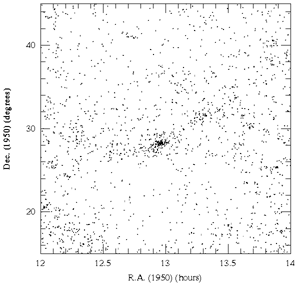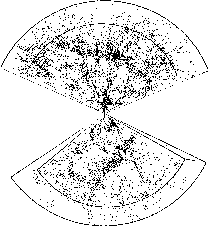


3.2.3. Clusters of Clusters -> Superclusters
As clusters of galaxies were cataloged it was noticed that some clusters were concentrated in certain regions of the sky. This can clearly be seen in the Abell Cluster catalog just by plotting up the spatial distribution of clusters. Figure 3.6 shows a 2D positional plot for galaxies near the Coma cluster. Apparent filamentary structure in which clusters are embedded is evident. Figure 3-7 shows the all sky positional data for all cataloged galaxies. The densest distribution of light points forms a linear feature, roughly perpendicular to the plane of the Milky Way (the black "zone of avoidance" feature running down the middle). This feature is known as the Super-Galactic plane in which the Virgo cluster (V) is embedded. In the positional data, it is clearly a very large scale feature. Superclusters of galaxies also appear in the Zwicky catalog but were not identified by Zwicky as such. In fact, Zwicky vigorously argued against the ideas of second order clustering or the systematic clustering of clusters to produce larger scale clusters. In the Zwicky catalog, superclusters show up as large, diffuse clusters which contain multiple condensations. Only when redshifts were obtained did the true scale of these structures become apparent.

|
Figure 3-6: Spatial plot of the position of galaxies in the Zwicky catalog located within 30 degrees of the center of the Coma cluster. Approximately 1900 galaxies are shown here and 200 alone define the Coma cluster. A hint of the Great Wall structure can also be seen in just this positional data. |
Superclusters are large structures whose radii are difficult to define in physically meaningful terms. A typical supercluster might contain 3-10 Abell clusters. Most all identifiable superclusters are elongated in shape and some appear to form a large scale filamentary pattern. For superclusters the dynamical timescale exceeds the expansion timescale of the Universe by several factors. A supercluster is best described as a collection of virialized condensations (e.g. clusters) that are mixed into an overall low density of galaxies. The clusters themselves fill very little of the volume of the structure. Outside the virialized condensations there is no X-ray emission and the velocity dispersion of the galaxies is low.

|
Figure 3-8: Combined Northern and Southern Hemisphere redshift surveys initiated by M. Geller and J. Huchra. These data best define the coherency of structure on rather large scales. |
But what about still larger scale structures, superclusters of superclusters? A pseudo three-dimensional plot of identified superclusters is shown in Figure 3-8. Since our census of superclusters is rather incomplete, Figure 3-8 is only suggestive. With a little imagination one can discern large scale clustering of superclusters. One of the strangest observations that has been made, however, is the apparent very large scale alignment of clusters and superclusters. As mentioned earlier, most superclusters are highly flattened structures. In that case a major axis can be defined by some position angle on the plane of the sky. In a study of these position angles, West (1989,1991,1994), has produced some evidence that there is alignment on scales of 50 - 100 Mpc. Furthermore, in some cases, this large scale alignment can be matched to the smaller scale alignment of the position angle of the radio emission axis of individual bright radio galaxies in the clusters of galaxies which are embedded in the flattened supercluster. This is circumstantial evidence for the memory retention of structure collapse over 6 orders of magnitude in spatial scale. It is difficult to know what to make of these alignment coincidences but the implications are quite provocative with respect to structure formation as gravitational collapse and dynamical relaxation should erase the memory of structure on larger size scales.